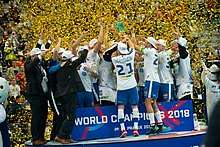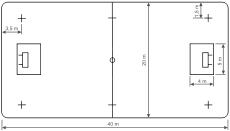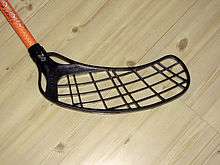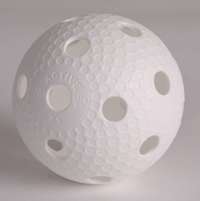Floorball
Floorball is a type of floor hockey with five players and a goalkeeper in each team. Men and women play indoors with 96–115.5 cm-long (37.8–45.5 in) sticks and a 70–72 mm-circumference (2.76–2.83 in) plastic ball with holes. Matches are played in three twenty-minute periods. Floorball was included in the World Games for the first time in 2017 in Wroclaw, Poland. Sweden were the first World Games gold medal winners.
 Finland celebrating after the gold in 2018 championship | |
| Highest governing body | International Floorball Federation |
|---|---|
| Nicknames | indoor bandy, innebandy, salibandy, unihockey, Plastic hockey, bandy |
| First played | late 1960s in Gothenburg, Sweden |
| Clubs | 4396 |
| Characteristics | |
| Contact | Yes |
| Team members | 6, including goalkeeper |
| Mixed gender | Yes, separate competitions |
| Type | Indoor |
| Equipment | Shoes, Floorball stick, Glasses for safety |
| Presence | |
| Country or region | Czechia, Denmark, Estonia, Finland, Germany, Latvia, Norway, Slovakia, Sweden, Switzerland |
| Olympic | No |
| Paralympic | No |
| World Games | 2017 |
The game was invented in Sweden in the late 1960s.[1] The basic rules were established in 1979 when the first floorball club in the world, Sala IBK, from Sala, was founded in Sweden.[2] Official rules for matches were first written down in 1981.[3]
The sport is organized internationally by the International Floorball Federation (IFF). As of 2014, there are over 300,133 registered floorball players worldwide.[4] Events include an annual Euro Floorball Cup for club teams and the biennial World Floorball Championships with separate divisions for men and women. Norway, Czechia, Finland, Sweden, and Switzerland have consistently placed 1st, 2nd, or 3rd at the World Floorball Championships. Professional club leagues include Finland's Salibandyliiga, Sweden's Svenska Superligan and Czech's Superliga florbalu.
While the IFF contains 74 members, floorball is most popular where it has been developed the longest, such as Czechia, Denmark, Estonia, Finland, Latvia, Norway, Sweden, and Switzerland. It is gaining popularity in Australia, New Zealand, India,[5] Canada,[6] Germany,[7] Ireland,[8] Japan,[9] Singapore,[10] Malaysia,[11] the United States.[12] and the United Kingdom.[13]
History
In various forms the game has been played since the early 20th Century in Canada as a recreational sport, especially in high school gymnasiums, as a playful variant of hockey, where the sticks got their form from the hockey game bandy. Most Canadian males born in the 1950s and before could attest to this. Similarly, during the 1950s and 1960s many public school systems within Michigan incorporated floorball into their primary and secondary school gym classes. Later, Americans claimed to have invented it, and held interstate tournaments in the 1960s.[14] The game was formally organized as an international and more organised sport in the late 1970s in Gothenburg, Sweden.[15][16][17] The sport began as something that was played for fun as a pastime in schools.[15] After a decade or so, floorball began showing up in Nordic countries where the former schoolyard pastime was becoming a developed sport. Formal rules soon were developed, and clubs began to form. After some time, several countries developed national associations, and the IFF was founded in 1986.
The game of floorball is also known by many other names, such as salibandy (in Finland), innebandy (in Sweden and Norway), and unihockey (in Switzerland and Ireland). The names "salibandy" and "innebandy" are derived from bandy; they translate to "hall bandy" and "indoor bandy" respectively. Unihockey is derived from "universal hockey" since it is meant to be a special and simplified hockey form.
Expansion
When the IFF was founded in 1986, the sport was played in mostly Nordic countries, Japan, and several parts of Europe. By 1990, floorball was recognized in 7 countries, and by the time of the first European Floorball Championships in 1994, that number had risen to 14. That number included the United States, who was the first country outside Europe and Asia to recognize floorball.[4] By the time of the first men's world championships in 1996, 20 nations played floorball, with 12 of them participating at the tournament.
As of 2009, the sport of floorball has been played in almost 80 countries. Of those, 58 have national floorball associations that are recognized by the IFF. With the addition of Sierra Leone, Africa's first floorball nation, the IFF has at least one national association on each continent of the world, with the exception of Antarctica.
Development
10 years after the IFF was founded, the first world championships were played, with a sold out final of 15,106 people at the Globen in Stockholm, Sweden. In addition to that, the world's two largest floorball leagues, Finland's Salibandyliiga and Sweden's Svenska Superligan were formed, in 1986 and 1995 respectively.
Recognition
In December 2008, the IFF and the sport of floorball received recognition from the International Olympic Committee (IOC). In July 2011, the IOC officially welcomed the IFF into its family of Recognised International Sports Federations (ARISF). This will pave the way for floorball to enter the official sport programme. The IFF hopes that this recognition will help allow floorball to become a part of the 2020 Summer Olympics.[18]
In January 2009, the IFF and the sport of floorball received recognition from the Special Olympics.[19]
In addition to recognition by the International Olympic Committee and Special Olympics, the IFF is also a member of the Sport Accord – formerly known as General Association of International Sports Federations (GAISF), and co-operates with the International University Sports Federation (FISU).[20] Floorball is now also member of IWGA which runs the World Games and floorball will be for the first time on programme in Wrocław 2017.
World championships
The world floorball championships are an annual event where teams from across the world gather to play in a tournament in order to win the world championship. As of 2011, eight Men's, eight Women's, six Men's Under-19, and four Women's Under-19 World Floorball Championships have taken place. Czechia, Finland, Norway, Sweden, and Switzerland remain the only five countries to have ever captured a medal at a World Championship event.
- The Men's World Floorball Championships take place every December (since 2008) in every even year.
- The Women's World Floorball Championships take place every December (since 2009) in every odd year.
- The Men's under-19 World Floorball Championships take place every May (since 2009) in every odd year.
- The Women's under-19 World Floorball Championships take place every May (since 2008) in every even year.
From 1996 to 2009, the IFF used a World Floorball Championship format where the last team in the A-Division was relegated to the B-Division, while the top team in the B-Division was promoted to the A-Division. This format caused much hardship for countries such as Australia, Canada, Slovakia, and Spain, who have all been trying to get to the B-Division from the C-Division since 2004. In 2010, the IFF adopted a FIFA-like continental qualification system, where teams must qualify to play at the world championships. Depending on the number of countries registered per continent or region, the IFF gives spots for the world championships. For example, Argentina, Brazil, Canada and the United States would need to play for one spot at the world championships in a continental qualification tournament for the Americas.[21]
Gameplay

Measurements
Floorball is played indoors on a rink whose size can officially vary from 18–20 m (59–66 ft) wide to 36–40 m (118–131 ft) long,[22] and which is surrounded by 50 cm (20 in) high enclosed boards with rounded corners. The goals are 160 cm (63 in) wide and 115 cm (45 in) high. Their depth is 65 cm (26 in) and they are 2.85 m (9 ft 4 in) from the end of the nearest boards. Face-off dots are marked on the center line. Dots are also marked 1.5 m (4 ft 11 in) from both sides of the rink on the goal lines imaginary extensions. The dots don't exceed 30 cm (12 in) in diameter. They do not have to be dots, they can also be crosses.[22]
Equipment

Typical equipment for a floorball player consists of a stick, a pair of shorts, a shirt, socks, and indoor sport shoes. Players may wear shin guards, eye protectors and protective padding for vital areas although most do not. Protective eyewear is, in some countries, compulsory for junior players.
A floorball stick is short compared with one for ice hockey; the maximum size for a stick is 114 cm. As a stick cannot weigh any more than 350 grams, floorball sticks are often made of carbon and composite materials. The blade of the stick can either be "right" or "left" which indicates which way stick is supposed to be held from the players point of view. A player who is right-handed will often use a "left" blade since this he/she will be holding the stick to left and the other way around for left-handed people.[23]
Goalkeepers
Goalkeepers wear limited protection provided by padded pants, a padded chest protector, knee pads and a helmet. Some goalkeepers like to wear gloves and/or wristbands The goalkeeper may also wear other protective equipment such as elbow pads and jock straps but bulky padding is not permitted. Goalkeepers do not use sticks and may use their hands to play the ball when they are within the goalkeeper's box. There, they are allowed to throw the ball out to their teammates provided that the ball touches the ground before the half court mark. When they are completely outside the box, goalkeepers are considered field players and are not allowed to touch the ball with their hands.
Ball

A floor ball weighs 23 g (0.81 oz) and its diameter is 72 mm (2.8 in). It has 26 holes in it, each of which are 10 mm (0.39 in) in diameter. Many of these balls now are made with aerodynamic technology, where the ball has over a thousand small dimples in it that reduce air resistance. There have been several times where a ball has been recorded to have traveled at a speed of approximately 200 km/h (120 mph).[24]
Rules
Each team can field six players at a time on the court, one player being a goalkeeper. But the coach can take the goalkeeper off and switch him with a field player whenever they like. Although it usually only happens in the end to score with one more outfield player. This can make advantages for the attacking side of the team, and disadvantages when it comes to their own defense. The team is also allowed to change players any time in the game; usually, they change the whole team. Individual substitution happens sometimes, but it usually happens when a player is exhausted or is hurt.
A floorball game is officially played over three periods lasting 20 minutes each (15 minutes for juniors). The time is stopped in the case of penalties, goals, time-outs and any situation where the ball is not considered to be in play. The signal of a timeout should be a triple sound.[22] An intermission of 10 minutes (or maximum 15 minutes in some competitions)[22] takes place between each period, where teams change ends and substitution areas. Each team is allowed one timeout of 30 seconds (which is often used late in matches). There are two referees to oversee the game, each with equal authority. If a game ends in a tie, teams play ten minutes extra, and the team that scores first wins.[22]. If the game is still drawn after extra-time, a penalty shootout similar to ice-hockey decides over the winner.
Checking is prohibited in floorball. Controlled shoulder-to-shoulder contact is allowed, but ice hockey-like checking is forbidden. Pushing players without the ball or competing for a loose ball is also disallowed, and many of these infractions lead to two-minute penalties. The best comparison in terms of legal physical contact is Association football (soccer), where checking is used to improve one's positioning in relation to the ball rather than to remove an opposing player from the play. In addition to checking, players cannot lift an opponent’s stick or perform any stick infractions in order to get to the ball. As well, players may not raise their stick or play the ball above their knee level, and a stick may not be placed between a player's legs. Passing the ball by foot is allowed, but only once, after that it the ball has to be touched by the stick. After stopping the ball by foot the ball has to be touched with the stick before it can be passed to a fellow player by foot (Rule change 2014). Passing by hand or head deliberately may result in a two minutes penalty for the offending player. A field player may not enter the marked goal area and playing without stick is prohibited.
When a player commits a foul, or when the ball is deemed unplayable, the play is resumed from a free-hit or a face-off. A free hit involves a player from one team to start play from the place where the ball was last deemed unplayable. A comparison of this is a free kick in soccer. For many fouls, such as stick infractions, a free hit is the only discipline provided. However, at the referee's discretion, a penalty may be worth either two or five minutes. At that point, the player who committed the foul sits in the penalty area, and his team is shorthanded for the time of the penalty. If an 'extreme' foul is committed, such as physical contact or unsportsmanlike behavior, a player may receive a 10-minute penalty or even a match misconduct.
Penalties
Two-minute penalties can arise from a number of infractions and result in the offending player being sat on a penalty seat next to the scorers/timekeepers and away from the team benches. Each penalty has a specific code that is recorded on the official match record along with the time of the foul. The team of the offending player will play short-handed for the full length of the penalty. The codes are as follows;
Two Minute Penalties
- 201: Hit
- 202: Blocking Stick
- 203: Lifting Stick
- 204: Incorrect Kick
- 205: High Kick
- 206: High Stick
- 207: Incorrect Push
- 208: Tackle/Trip
- 209: Holding
- 210: Obstruction
- 211: Incorrect Distance
- 212: Lying Play
- 213: Hands
- 214: Header
- 215: Incorrect Substitution
- 216: Too Many Players
- 217: Repeated Offences
- 218: Delaying
- 219: Protest
- 220: Incorrect Entering of the Rink
- 221: Incorrect Equipment
- 222: Measuring Stick
- 223: Incorrect Numbering
- 224: Play without Stick
- 225: Non-removal of Broken Stick
- 226: Penalty at Penalty Shot
5 Minute Penalties
- 501: Violent Hit
- 502: Dangerous Play
- 503: Hooking
- 504: Roughing
- 505: Repeated Offences
Personal Fouls/Penalties
- 101: Unsportsperson-like Behaviour
Forms
Freebandy
Freebandy is a sport that developed in the 2000s from floorball fanatics who specialize in a technique called "zorro", which involves lifting the ball onto a stick and allowing air resistance and fast movements to keep the ball "stuck" to the stick. This technique is also referred to as "airhooking" or "skyhooking". In freebandy, the rules are very much the same of those of floorball, with the exception of high nets and no infractions for high sticking. As well, the sticks are slightly tweaked from those of a floorball variety to include a "pocket" where the ball can be placed.
Special Olympics
Floorball at the Special Olympics is slightly modified from the "regular" form of floorball. Matches are played 3-on-3 with a goaltender, on a smaller court that measures 20 metres (66 ft) long by 12 metres (39 ft) wide. This form of floorball was developed for the intellectually disabled, and has yet to be played at the Special Olympics. Floorball was played as a demonstration sport at the 2013 Special Olympics World Winter Games,[25] and was played as an official sport at the games in 2017.[26]
Streetbandy
A simplified less formal version of Floorball, played with smaller team numbers and shorter periods, and typically outdoors on various surfaces, including AstroTurf. In its most basic form, it is an informal pick up game amongst friends. However, a more formal version is played in Sweden, with the following structure:[27]
- 3 field players on each team, with smaller overall team sizes (including subs.)
- small goals, with no goalie
- smaller playing area, usually closer to a half rink.
- 10 minute length.
- tendency towards "first team to score 5 goals in the time limit" rather than traditional scoring. Sudden death on a draw.
- penalties are taken from the centre line.
- most situations arising from the ball leaving play are resumed from a fixed point (e.g. corner, centre line)
- no physical contact, high sticks or dangerous activity allowed.
Swiss floorball
Swiss floorball called unihockey is a revised version of a floorball match. The match is played on a slightly smaller court and often involves only three field players playing on each side, in 3-on-3 floorball. This form of floorball is also slightly shorter, with only two periods of 15 to 20 minutes each played. In Switzerland this form of playing is called "smallcourt" (Kleinfeld), opposed to the usual style of playing on a bigger court, which is called "bigcourt" (Grossfeld).
Wheelchair floorball
Originally developed for players with disabilities, wheelchair floorball is played with exactly the same rules as "regular" floorball. Players use the same stick and ball, and goaltenders are also allowed to play.
The first ever IFF-sanctioned wheelchair floorball matches were played between the men's teams of Czechia and Sweden, during the 2008 Men's World Floorball Championships in Prague, Czechia.
In addition to this, there is also an electric wheelchair variation.
Competitions
In addition to the Floorball World Championships, there are other IFF Events for club teams such as the Champions Cup which is for the national competition winners from the Top-4 ranked nations, and the EuroFloorball Cup for the national competition winners from the 5th and lower ranked nations. There are also many international floorball club competitions.
Asia Pacific Floorball Championship
The Asia Pacific Floorball Championships are played every single year in New Zealand, Australia, Singapore, or Japan. The event was created by the Singapore Floorball Association together with the cooperation of the Asia Oceania Floorball Confederation (AOFC). Members of the AOFC get together during this tournament to play for the Asia Pacific Floorball Championship every year. The most recent champions are Men's national floorball team of Australia.
As of 2010, the Asia Pacific Floorball Championship is also the qualifying tournament for the World Floorball Championships.
Canada Cup
The Canada Cup is an international club tournament that is held every year in Toronto, Ontario, Canada. It is the largest floorball club tournament outside of Europe, and attracts 55+ clubs from worldwide, every year. The winners of the 2015 Canada Cup floorball tournament were the Ottawa Blizzard floorball club.
USA Cup
The USA Cup is an international club tournament that is held annually in Dallas–Fort Worth metroplex, United States. It is a part of NAFC series with Canada Cup and Falls floorball classic.
NAFC - North American Floorball Championship
The NAFC - North American Floorball Championship is an international club tournament series currently including three tournaments: Canada Cup, Falls floorball classic and USA Cup. Teams must attend at least one tournament in Canada and one in the United States with a roster that is made up of at least 50% of the same players and using the same club name to be eligible.
Czech Open
The world's largest club team tournament, the Czech Open is a traditional summer tournament held in Prague, Czechia. It is famous not only for its on-court activities, but also for those off-court. The tournament attracts 200+ clubs every year from 20 different countries. The most recent champions of the prestigious Czech Open are Sweden's IBF Falun.
Champions Cup
The Champions Cup was played for the first time in 2011. It is now the premier IFF event for Men's and Women's Club teams. The national championship winners from the Top-4 ranked nations receive automatic qualification, while the remaining two spots are made up by a team nominated by the Local Event organiser and the winner of the previous year's EuroFloorball Cup.
In 2011, the winners were Men: SSV Helsinki (Finland) and Women: IF Djurgårdens IBF (Sweden).[28]
EuroFloorball Cup
The EuroFloorball Cup (formerly European Cup) is an IFF-organised club event for both men's and women's teams. It has taken place every single year since 1993, and in 2000 it changed its format to a 2-year event (i.e. 2000–01). In 2008, the tournament switched back to its one-year format. In 2011 it underwent another change when the Champions Cup was introduced for the first time.
The EuroFloorball Cup (EFC) is now for the national competition winners from the 5th and lower ranked nations. Qualification can be made via a number of processes. Firstly, the teams from the 5th, 6th & 7th ranked nations receive automatic qualification. A team nominated by the local event organiser also gets automatic qualification, and then the last two spots are determined by qualification tournaments.
The winner of the EFC qualifies to play in the Champions Cup the following year. The reigning EuroFloorball Cup Champions as of October 2011, are Men: RTU/Inspecta (Latvia)and Women: RSU/Runway (Latvia).[29]
See also
Notes and references
- "Floorball | IWGA". www.theworldgames.org. Retrieved 22 April 2018.
- "Innebandyns födelse - Innebandy.se". Innebandy.se (in Swedish). Archived from the original on 8 September 2018. Retrieved 7 September 2016.
- Houmann, Steen (2006). "Skolernes Floorball" (PDF) (in Danish). Et samarbejde af Dansk Skoleidræt og Dansk Floorball Union. Archived from the original (PDF) on 2 April 2015. Retrieved 7 September 2016. p. 2
- "History in short - IFF". floorball.sport. Retrieved 26 January 2020.
- "Floorball Australia > Home". Floorballaustralia.org. Retrieved 7 September 2016.
- "What is floorball?". Globalnews.ca. Retrieved 7 September 2016.
- "Floorball Deutschland". Floorball.de (in German). Retrieved 6 September 2016.
- "Killarney Vikings". Killarneyvikings.yolasite.com. Retrieved 7 September 2016.
- トップページ. Floorball.jp (in Japanese). Retrieved 7 September 2016.
- "Interview with GK from Singapore!". innebandyplaneten.se. Archived from the original on 18 April 2015. Retrieved 18 April 2015.
- "MALAYSIA FLOORBALL ASSOCIATION". Floorballmalaysia.com. Retrieved 6 September 2016.
- ""Wayne Gretzky älskar innebandy"". Aftonbladet.se (in Swedish). Retrieved 6 September 2016.
- "UKFF - Home". Retrieved 26 January 2020.
- "DEVELOPMENT OF FLOORBALL : Floorball Coach – everything about floorball training". Floorballcoach.org. Archived from the original on 31 December 2019. Retrieved 7 September 2016.
- "The History of Floorball". floorballnation.com.au. Archived from the original on 24 April 2013. Retrieved 7 September 2016.
- Malm, William; Olsson, Rebecca (1998). "Floorball - The Future Sport". www.freeway.org. Archived from the original on 16 March 2013. Retrieved 7 September 2016.
- "The True History of Floorball". www.floorballcentral.org. 16 January 2010. Archived from the original on 10 September 2016. Retrieved 7 September 2016.
- "Floorball moves towards becoming an Olympic Sport". Floorball.org. 12 December 2008. Archived from the original on 5 March 2016. Retrieved 7 September 2016.
- "Floorball receives recognition by the Special Olympics". Floorball.org. 23 January 2009. Archived from the original on 4 March 2016. Retrieved 7 September 2016.
- "The IFF". floorball.sport. Retrieved 26 January 2020.
- "WFC new style system" (PDF). floorball.org. Retrieved 27 January 2020.
- "Rules of the Game". floorball.sport. 1 July 2018. Retrieved 26 January 2020.
- "New World Record". Floorballcentral.org. 5 November 2010. Archived from the original on 6 May 2017. Retrieved 7 September 2016.
- "Special Olympics: Floorball". Specialolympics.org. Retrieved 7 September 2016.
- Mariusz Damentko (14 May 2014). "Special Olympics: Floorball is now an official Special Olympics World Games Sport". Specialolympics.org. Archived from the original on 29 July 2018. Retrieved 7 September 2016.
- "Streetbandy". Streetgames.se (in Swedish). Archived from the original on 17 September 2016. Retrieved 7 September 2016.
- "Champions Cup 2011". Floorball.org. Retrieved 26 January 2020.
- "EuroFloorball Cup Final Round 2011". Floorball.org. Retrieved 7 September 2016.
